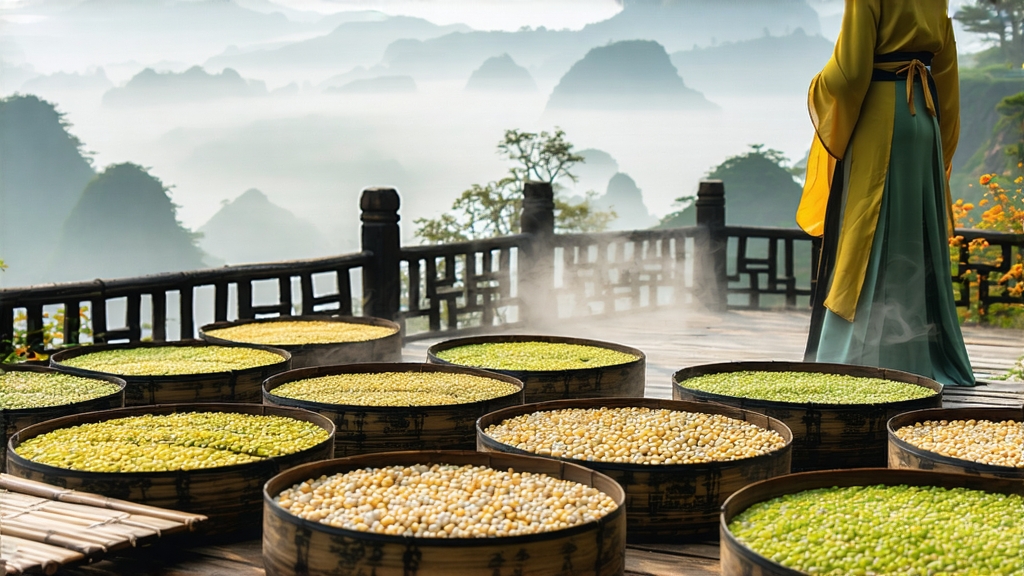
Tucked high above the Sichuan basin, where the Min River cuts through perpetual cloud, Meng Ding Mountain has been China’s most continuous tea garden for twelve centuries. Among its legendary crops none is more elusive than Meng Ding Huang Ya—literally “Meng Ding Yellow Bud”—a tea so scarce that even lifelong Chengdu residents may have tasted it only once. To foreigners the name is almost unknown, yet this single variety embodies the entire philosophy of yellow tea: the deliberate surrender of speed in exchange for a flavour that seems to remember mountain mist and Buddhist bells.
A leaf born of poetry and politics
The first written record appears in 808 CE, when the Tang court fixed a list of “tribute teas” to be sent along the newly opened Jiannan Road. Meng Ding, already famous for its spring green tea, was ordered to present the finest one-leaf-and-bud pickings wrapped in silk and cooled with snow from the summit. Sometime during the Song dynasty the monks of Ganlu Temple—Meng Ding’s spiritual heart—began experimenting with a slow oxidation wrapped in thick cloth. The process turned the leaf a muted golden-green and softened the astringency that so often offended imperial palates. By the Ming, the tea was christened Huang Ya and reserved for the emperor’s private altar during the spring sacrifice. Export was forbidden; seeds were smuggled out only once, in 1904, by a Jesuit botanist who confused it with a light oolong. Thus the West never noticed its disappearance when twentieth-century turmoil closed the mountain gardens.
Micro-terroir on the roof of Sichuan
Meng Ding is not a single peak but a granite ridge whose highest point, Shangqing Peak, lifts 1 456 m above sea level. The slope faces east, catching the first light yet shaded by evergreen oaks that exhale moisture throughout the day. The soil is a crumbly quartz-rich loam, so acidic (pH 4.3) that even azaleas grow stingily. Temperature swings of 15 °C between day and night force the tea bush to thicken cell walls, concentrating amino acids. Most crucial is the fog: a reliable blanket 280 days a year that filters ultraviolet light and encourages slow, even growth. Local proverb says “three days of sun, seven days of cloud—only then can a yellow bud form.”
Three cultivars, one name
Farmers distinguish three clonal bushes under the umbrella name Meng Ding Huang Ya:
- Ganlu #1 – the original temple strain, small leaf, lilac nose.
- Shangqing #9 – bred in the 1970s for frost resistance, broader leaf, honey note.
- Chuanhuang #3 – a 2007 release with higher theaflavin content, designed for the export market yet still produced in tiny lots.
All three are picked between the Qingming festival and Grain Rain, when the bud measures 18–22 mm and still hides its first unfurling leaf inside like a folded paper fan.
The craft: slowness as technique
Unlike green tea that must kill-green within minutes, yellow tea courts time. The moment baskets arrive at the cottage workshop, leaves are spread on 2 mm-thick bamboo trays and withered for 90 minutes at 28 °C. The goal is not desiccation but the loss of grassy “raw edge.” Next comes the signature shaqing: wok-firing at 160 °C for four minutes with bare-handed tossing. The master’s palm reads the leaf’s pliability, stopping when the bud feels like wet suede. Immediately the hot leaf is piled 8 cm deep inside a linen bag and transferred to the “yellowing room,” a pine-panelled cupboard kept at 34 °C and 78 % humidity. Here the bag rests for 48 hours, unopened. Enzymatic oxidation—never to be confused with microbial fermentation—proceeds in the absence of oxygen, turning chlorophyll into pheophytin and releasing a cascade of floral lactones. Every twelve hours the pile is gently turned to equalise temperature; the master listens for the faint rustle that signals moisture redistribution. Finally the leaf is given a second, cooler wok pass (120 °C) to set the colour, then baked over charcoal embers for three consecutive nights until moisture drops to 5 %. The entire choreography spans five days, during which the leaf loses 72 % of its